The Hidden Dangers of a "Minor" Leak
Leaky pipe repair might seem like a small problem, but even a tiny drip can quickly spiral into a costly disaster. The numbers are staggering: a copper pipe leak with a hole the size of a grain of rice wastes 3,000 liters of water in a single day. If that hole grows to pea-size, you're looking at over 10,000 liters daily.
Quick Guide to Leaky Pipe Repair:
- Turn off the main water supply immediately
- Drain the pipes by opening faucets
- Clean and dry the damaged area
- Choose a temporary fix: pipe clamp, epoxy putty, or self-fusing silicone tape
- Call a professional for permanent repair
Beyond water waste, that "harmless" drip creates the perfect conditions for mold growth, can rot floors and cabinets, and may cause serious structural damage to your home. The good news is you can take immediate action. Temporary fixes buy you precious time and can prevent thousands of dollars in water damage while you arrange for professional help.
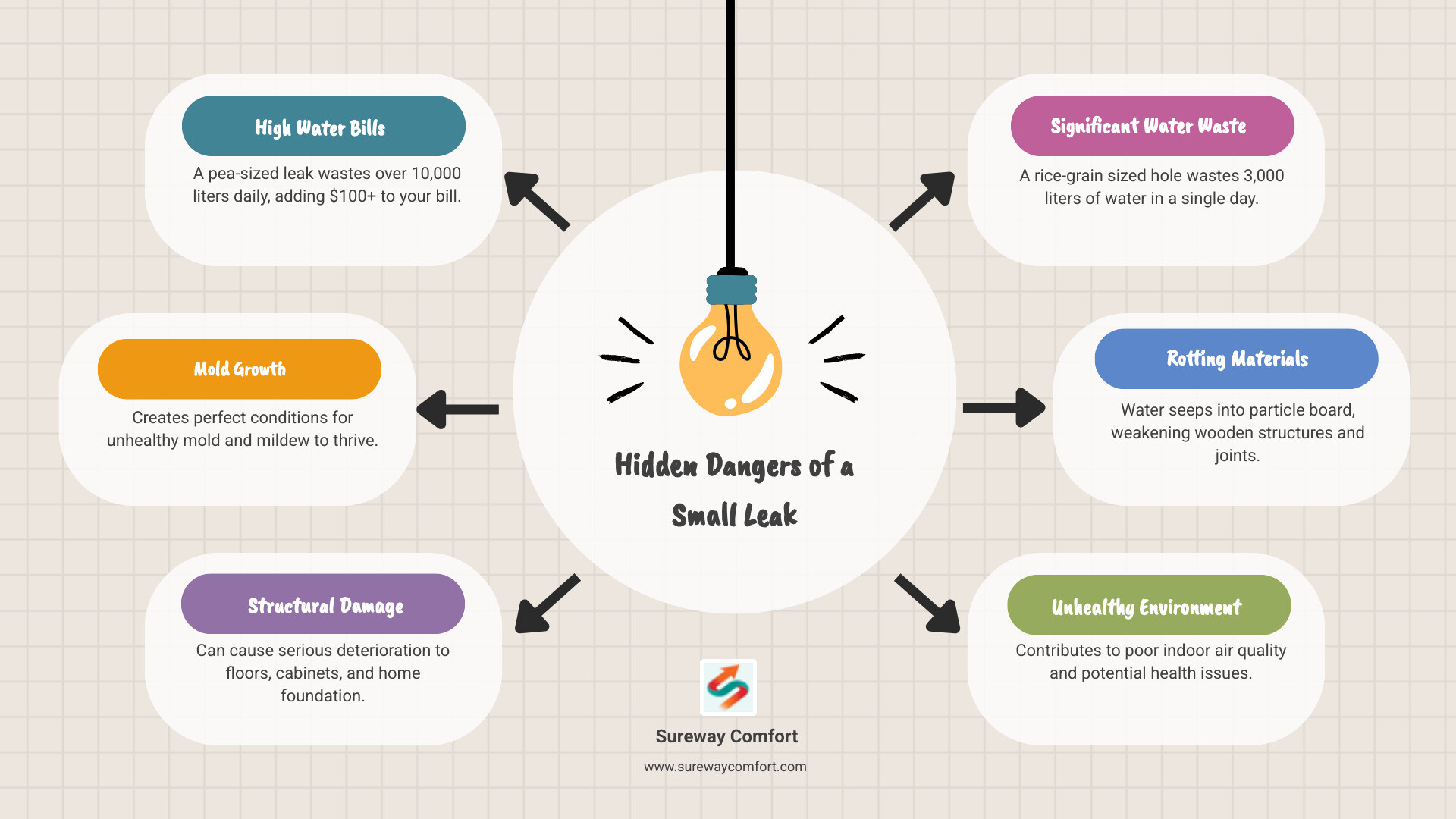
Leaky pipe repair vocab explained:
First Response: What to Do When You Find a Leak
When you find a leaky pipe, taking the right steps immediately can save you thousands. Your first priority is shutting off the main water valve. Know where this valve is before you need it—it's typically where the main water line enters your home, often in the basement or a utility closet.
Once the water is off, drain the pipes by opening all faucets, starting with the lowest ones. This releases trapped pressure and makes your leaky pipe repair safer. Place a bucket under the leak to catch remaining water. Crucially, if the leak is near electrical outlets, turn off the power at the circuit breaker. Water and electricity are a dangerous combination.
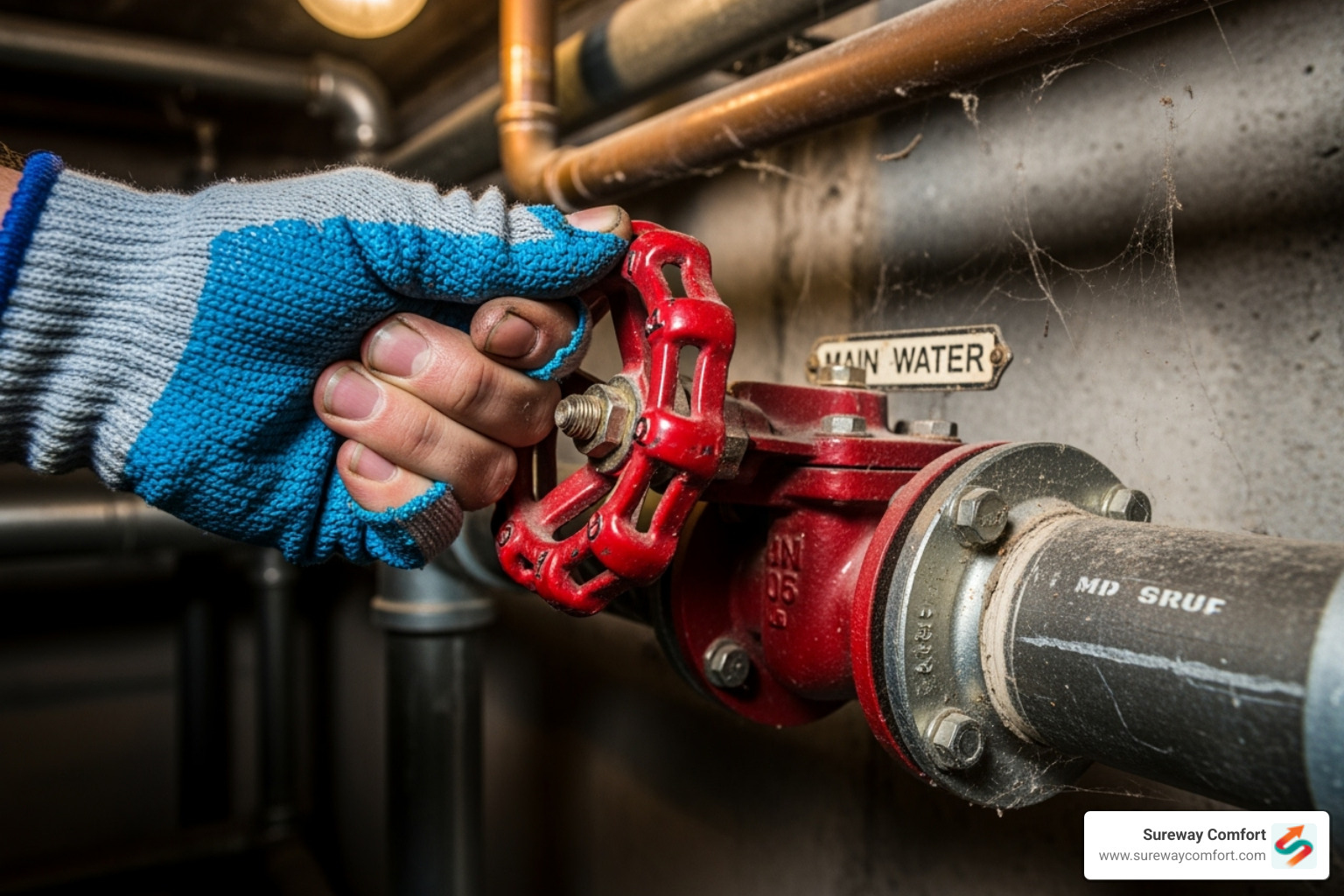
Sometimes leaks are obvious, but other times the clues are subtle. Watch for:
- Puddles and wet spots: The clearest sign, often under sinks or near appliances.
- Musty smells: A damp, earthy odor often signals hidden mold from a persistent leak.
- Wall and ceiling stains: Discoloration or bubbling paint points to water behind the scenes.
- Spiking water bill: A sudden increase without a change in usage can indicate a hidden leak.
- Sounds of running water: Dripping sounds when all fixtures are off is a clear warning.
Common causes for leaks include corrosion in older pipes, high water pressure stressing the system, loose joints, and frozen pipes during our Pennsylvania winters—a regular issue in areas like Bridgeville and Bethel Park. Physical damage and simple aging infrastructure also contribute.
Identifying Your Pipe Type
Before any leaky pipe repair, identify your pipe material, as it affects the repair method.
- Copper: Reddish-brown pipes used for water supply. Durable but can develop pinhole leaks.
- PVC: Rigid white plastic pipes, common for drains, waste, and some cold water lines.
- PEX: Flexible, colorful tubes (red for hot, blue for cold) used for water supply. Resists freezing and corrosion.
- CPVC: Cream or tan-colored plastic pipes for both hot and cold water supply, handling higher temperatures than PVC.
- Galvanized: Gray, magnetic steel pipes found in older homes. Prone to internal rust and leaks as the zinc coating wears away. Many areas no longer approve galvanized pipes for new installations.
- ABS: Black plastic pipes typically used for drain, waste, and vent systems.
Your Guide to Temporary Leaky Pipe Repair Methods
A well-executed temporary fix can be your lifeline, giving you time to arrange professional help without your home flooding. With a few basic tools, you can stop a leak and protect your home from further damage.
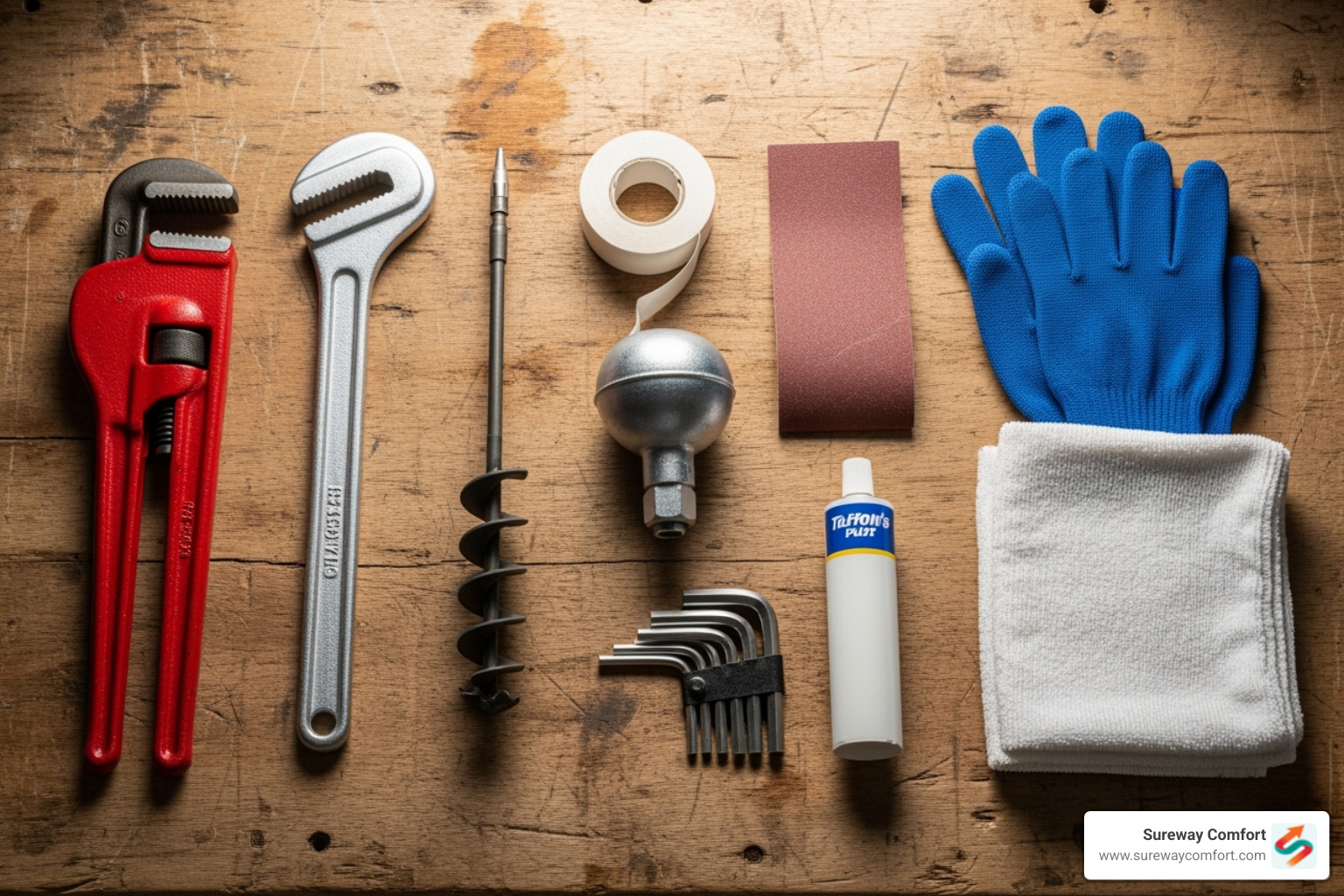
Preparing the Pipe for a Temporary Repair
Preparation is key to a successful repair. First, clean the area around the leak to remove any grime. Next, dry the pipe thoroughly, as moisture prevents repair materials from bonding. For some repairs, like epoxy, roughen the surface with fine sandpaper to give the material a better grip.
Method 1: Using a Pipe Clamp
Pipe clamps are excellent for pinhole leaks and small cracks on straight pipes. You'll need a clamp matching your pipe's diameter, a rubber sleeve, and a screwdriver. Position the rubber sleeve over the leak, ensuring it's fully covered. Wrap the clamp around the pipe, centering it over the sleeve. Tighten the screws evenly until the gasket forms a snug seal, stopping the leak without damaging the pipe.
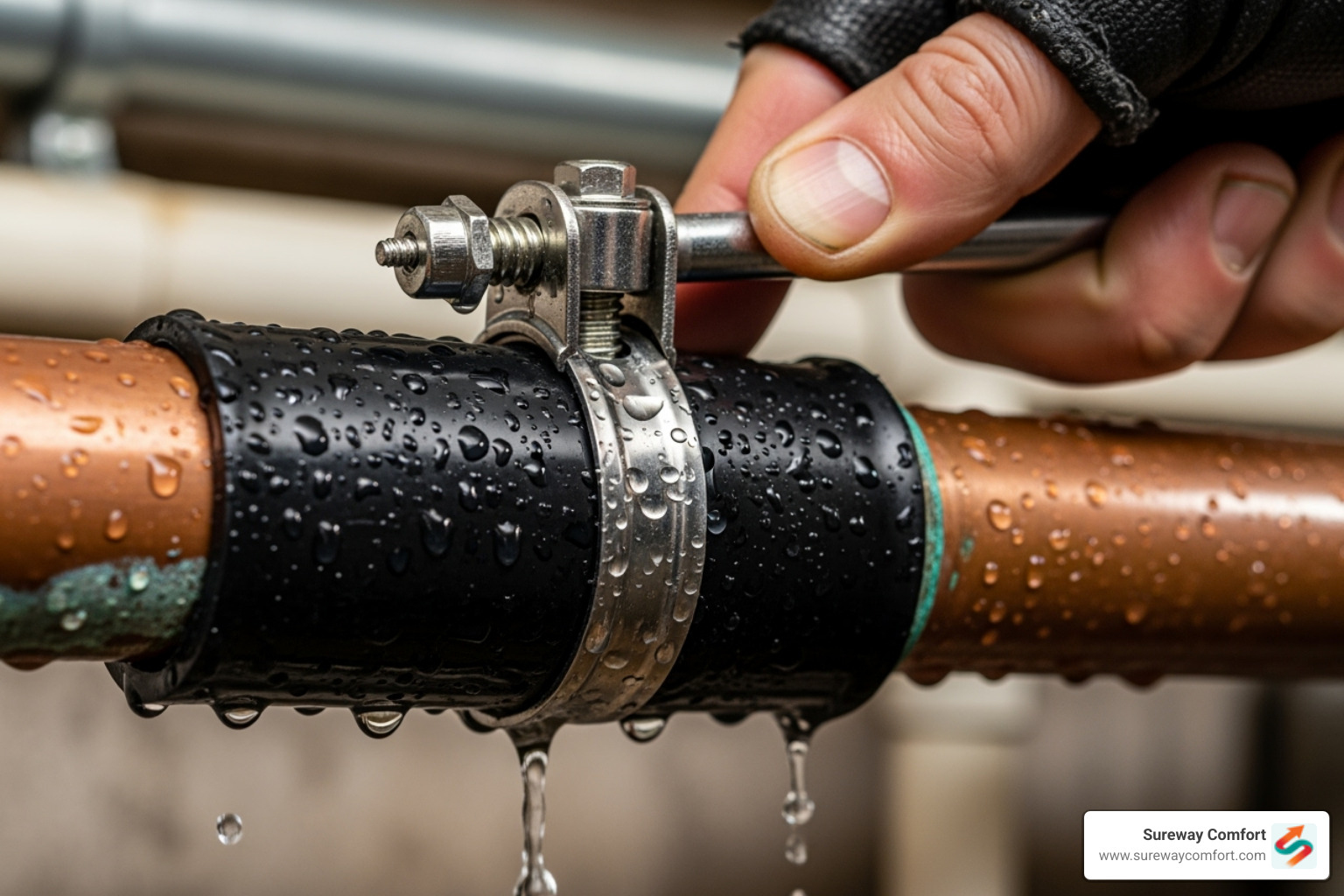
Method 2: Applying Epoxy Putty
Epoxy putty is versatile, perfect for small holes on straight pipes or joints where a clamp won't fit. Wearing nitrile gloves, cut off a piece of the two-part putty and knead it until the color is uniform. The putty will get warm as it activates. Quickly mold the putty over the leak, pressing it firmly and extending it beyond the damaged area. It will harden within minutes, so check the manufacturer's instructions for full curing time before turning the water back on.
Method 3: Wrapping with Self-Fusing Silicone Tape
This tape is a fast solution for minor leaks on low-pressure lines. All you need is the tape itself. Press one end firmly against the pipe next to the leak. Stretch the tape as you wrap it around the pipe, overlapping each layer by at least half the tape's width. This tension activates its self-fusing properties. Wrap several layers, extending well beyond the leak to create a seamless, waterproof barrier.
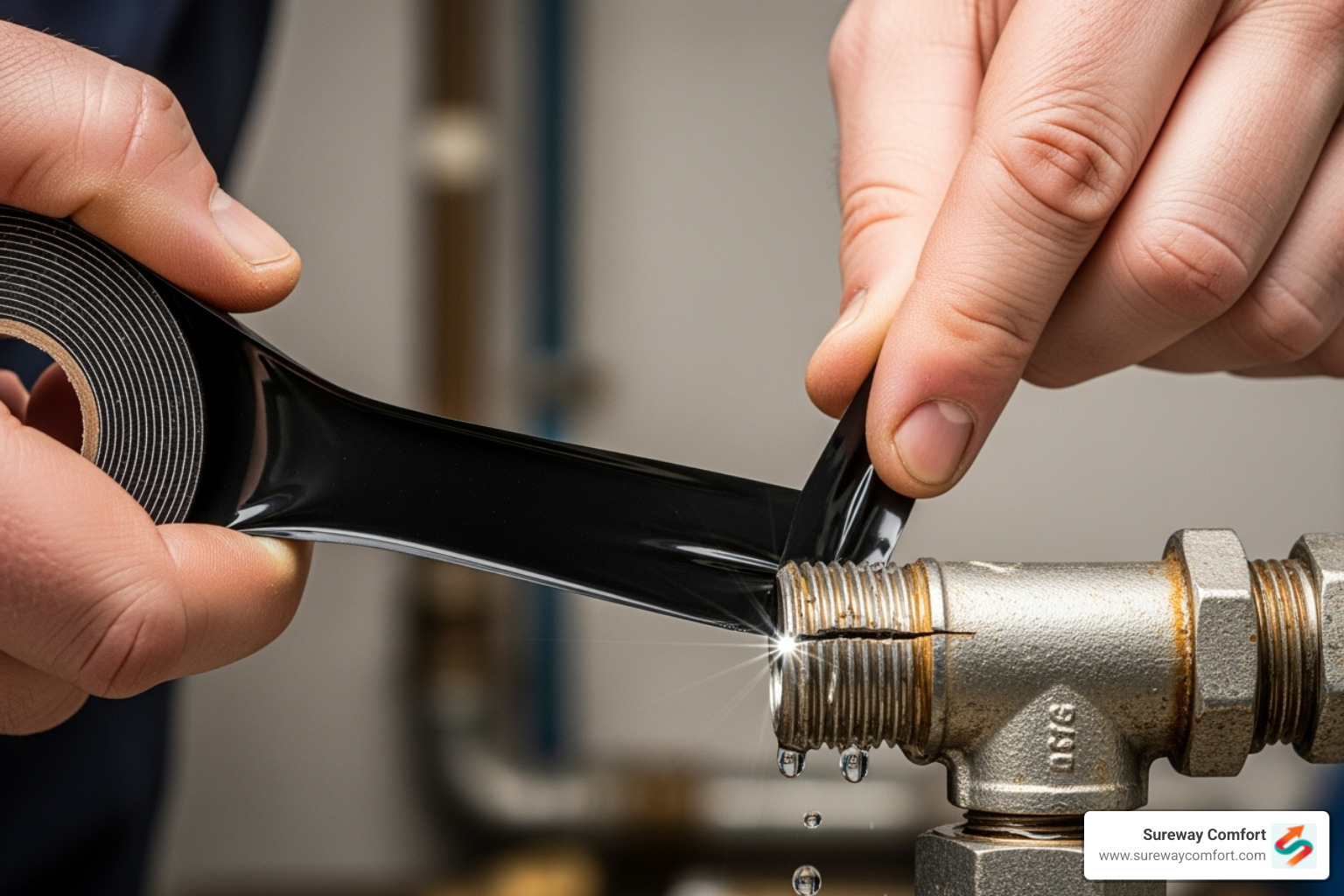
Comparing Your Temporary Fix Options
Each leaky pipe repair method has its strengths. Pipe clamps offer the most secure, high-pressure solution but only work on straight pipes. Epoxy putty is versatile for joints and irregular surfaces but requires quick work. Self-fusing silicone tape is the fastest and cleanest for low-pressure lines but isn't ideal for high-pressure leaks. These are temporary solutions. For a permanent fix, contact a professional plumber.
After the Fix: Cleanup and Professional Follow-Up
You've stopped the leak, but the job isn't finished. Your temporary fix prevented a disaster; now it's time to clean up and plan for a permanent solution.
Preventing Mold and Water Damage
Lingering moisture can cause problems long after a leak is fixed. Take these steps to prevent mold and further damage:
- Dry the area thoroughly: Use towels for visible water, then run fans and a dehumidifier to dry out cabinets and tight spaces.
- Disinfect all wet surfaces: A household disinfectant or a bleach solution (1 cup bleach per gallon of water) will prevent mold and mildew.
- Inspect for damage: Check cabinets and drywall for soft spots, crumbling, or discoloration. Water-damaged materials may need to be replaced.
When to Call a Professional Plumber
Temporary repairs are not permanent solutions. Your DIY fix is a band-aid that buys you time. You absolutely need to call a professional if:
- Your temporary fix isn't holding or the leak returns.
- You're dealing with large cracks or a burst pipe.
- You see signs of widespread corrosion on your pipes.
- The leaking pipe is behind a wall or under a floor.
- You are experiencing frequent leaks throughout your home.
- You feel uncertain or uncomfortable with the repair process.
At Sureway Comfort, our experienced technicians serve homeowners throughout Bridgeville, South Fayette, Upper St. Clair, and Bethel Park with reliable leaky pipe repair services. We can quickly assess your situation and provide a permanent solution for your peace of mind.
Ready to turn your temporary fix into a permanent solution? Contact us - we're here to help.
From Temporary Patch to Permanent Solution
Your temporary fix has bought you time, but now it's time to plan for a permanent leaky pipe repair. A DIY patch is a bandage; you still need proper care for a complete fix.
Long-Term Solutions for Leaky Pipe Repair
Professional plumbers use several methods for lasting repairs, depending on the pipe and damage:
- Pipe Section Replacement: The most common solution, where the damaged section is cut out and replaced with new pipe. This often involves professional soldering for copper or specialized fittings for PEX and PVC.
- Slip Couplings: These connectors, like the ones you can find on Amazon, slide over pipes to join a new section, but require professional installation for a lasting seal.
- Full Re-piping: For homes with aging systems or frequent leaks, replacing all plumbing with modern PEX or copper is a wise long-term investment.
- Trenchless Repair: An innovative method for fixing underground main water lines without extensive digging in your yard.
How to Prevent Future Pipe Leaks
The best leaky pipe repair is the one you never have to make. A few simple habits can keep your pipes healthy:
- Regular Inspections: Monthly, check exposed pipes under sinks and in the basement for corrosion or dampness.
- Manage Water Pressure: If your pressure is consistently above 80 psi, a pressure regulator can prevent stress on your pipes.
- Winterize Outdoor Pipes: In our Pennsylvania climate, disconnect hoses and shut off water to outdoor spigots before winter to prevent burst pipes.
- Address Water Hammer: Banging sounds in your walls when water turns on or off indicate pressure surges that can cause damage over time. Call a pro if you hear them.
- Avoid Harsh Chemicals: Chemical drain cleaners can corrode pipes. Use gentler enzymatic cleaners or professional hydro jetting services instead.
At Sureway Comfort, we've helped countless homeowners in Bridgeville, South Fayette, and Bethel Park turn temporary fixes into permanent solutions. Our technicians can recommend the most effective approach for your home.
Frequently Asked Questions about Leaky Pipe Repair
When you're dealing with a leaky pipe repair emergency, questions are common. We've helped countless homeowners in Bethel Park, Bridgeville, and surrounding areas, so here are answers to the questions we hear most.
How long does a temporary pipe repair last?
A temporary fix is a band-aid, not a permanent solution. It might hold for a few hours or several weeks, depending on water pressure, the size of the leak, and the repair method used. A pipe clamp on a straight pipe may last longer than silicone tape on a high-pressure line. We always advise customers not to push their luck. Use the time a temporary fix buys you to schedule a professional permanent repair to avoid a sudden failure.
Can I use duct tape to fix a leaky pipe?
While it seems like a universal fix, duct tape should not be used to repair a pressurized water pipe. Its adhesive is not waterproof and will quickly fail under pressure, leading to a bigger mess. For a low-pressure drain line, it might offer a few minutes of drip control while you get proper materials, but you are far better off using products designed for plumbing, like self-fusing silicone tape or epoxy putty. Save the duct tape for other household repairs.
What's the difference between a supply line leak and a drain line leak?
Understanding this difference helps gauge the urgency of the problem.
Supply line leaks occur in pipes bringing fresh, pressurized water into your home. Because they are under constant pressure, water flows continuously from the leak, demanding immediate action to prevent rapid water waste and damage. If a puddle under your sink grows even when the faucet is off, it's likely a supply line issue.
Drain line leaks happen in pipes carrying wastewater away from sinks and showers. These pipes are not pressurized, so they only leak when water is flowing through them. While less immediately urgent, they still pose risks by creating unsanitary conditions and causing water damage and mold over time.
Both leak types need professional attention, but supply line leaks are a true emergency. If you're dealing with either situation in the Bethel Park area, contact us for reliable residential plumbing services.
Conclusion: Secure Your Home with a Professional Repair
A small drip can quickly become a nightmare, but now you know how to take immediate action. Whether using a pipe clamp, epoxy putty, or self-fusing silicone tape, you can stop the flow and prevent catastrophic water damage. That rice-grain sized hole wasting thousands of liters daily is a serious threat to your home and health.
However, these DIY leaky pipe repair methods are temporary lifelines, not permanent solutions. A patch can fail without warning, leading to flooded floors, ruined cabinets, and dangerous mold growth. The stress of wondering "when will it fail?" isn't worth the gamble.
Professional plumbers bring experience to diagnose underlying problems and perform repairs that will last for years, not days. When our experienced technicians at Sureway Comfort arrive at your Bethel Park, Bridgeville, or South Fayette home, they're not just fixing a leak—they're securing your family's comfort and your home's future.
Our streamlined process means you get a fast assessment and a reliable fix. Don't let your temporary hero become tomorrow's villain. For a permanent solution that lets you sleep soundly, trust the professionals who have been keeping Western Pennsylvania homes dry for years.
Contact us for reliable residential plumbing services in Bethel Park, PA – because your home deserves better than a band-aid solution.



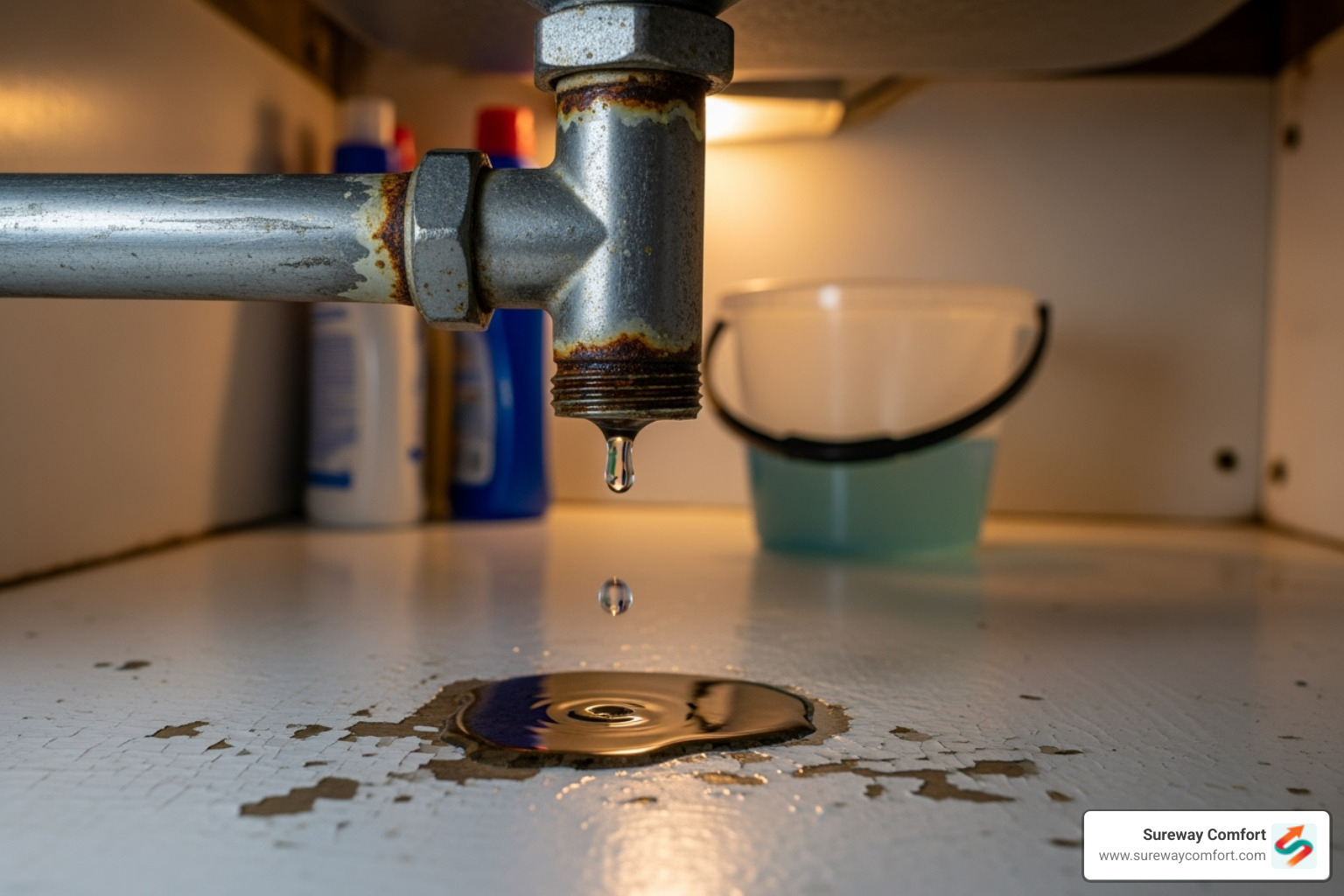
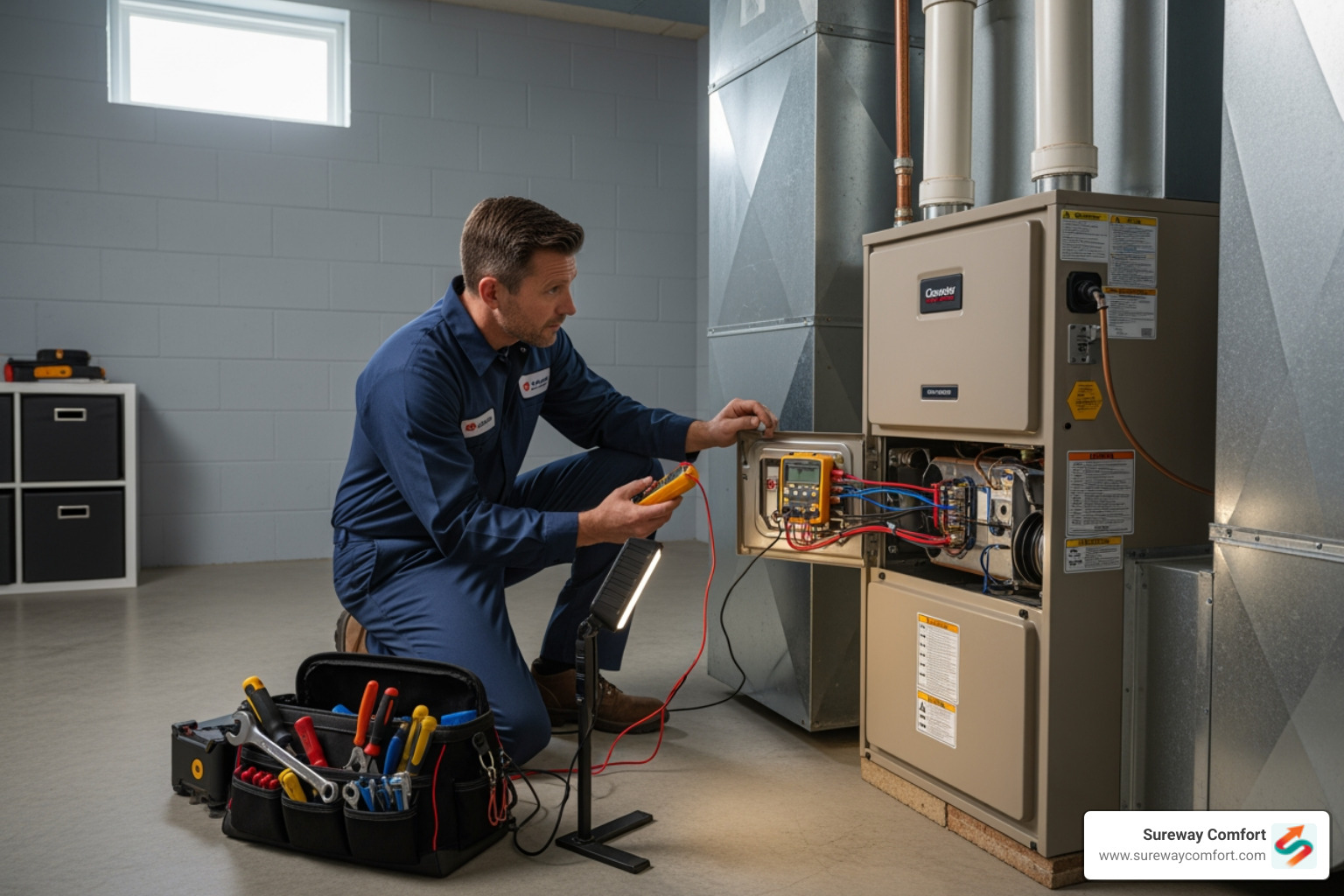

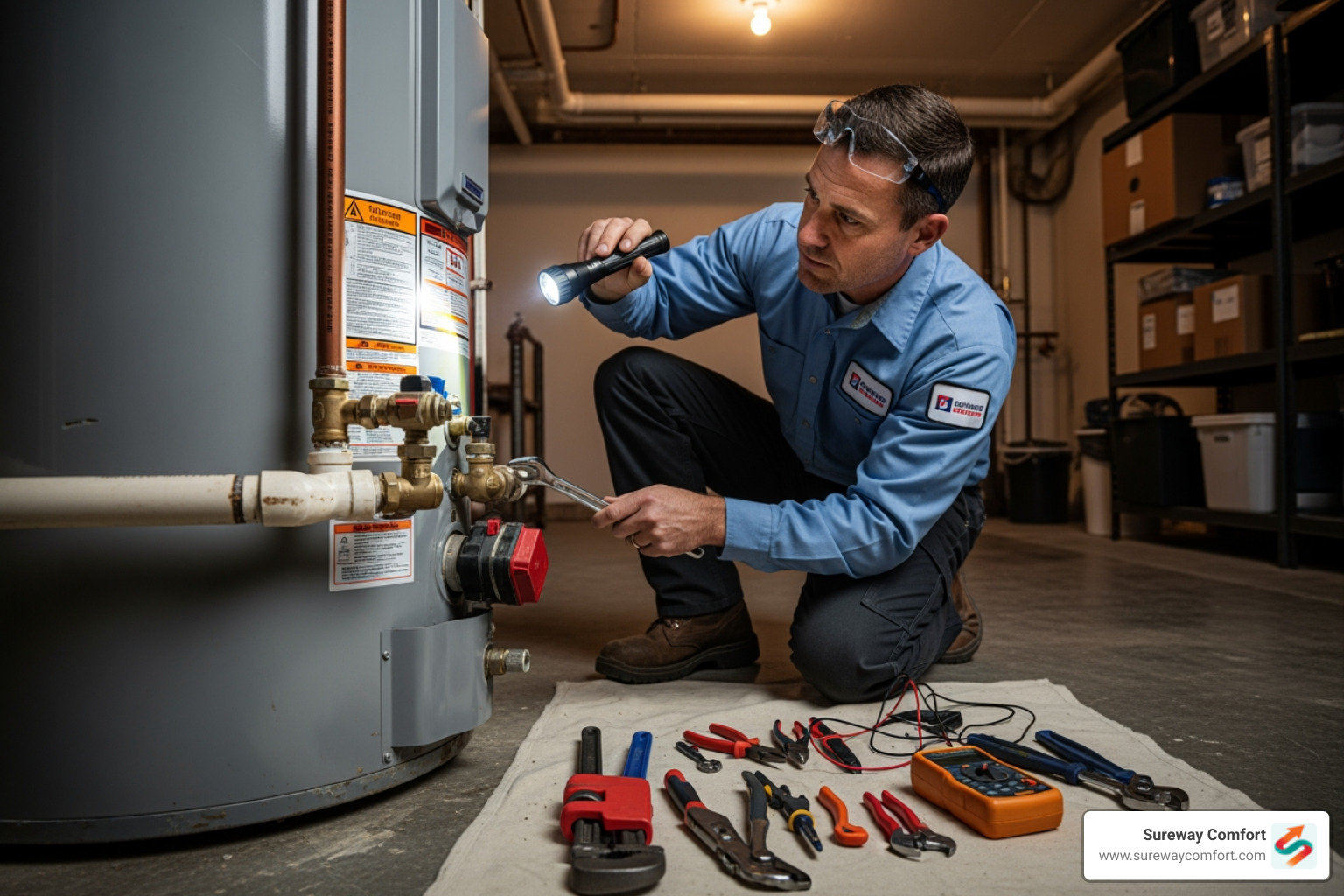
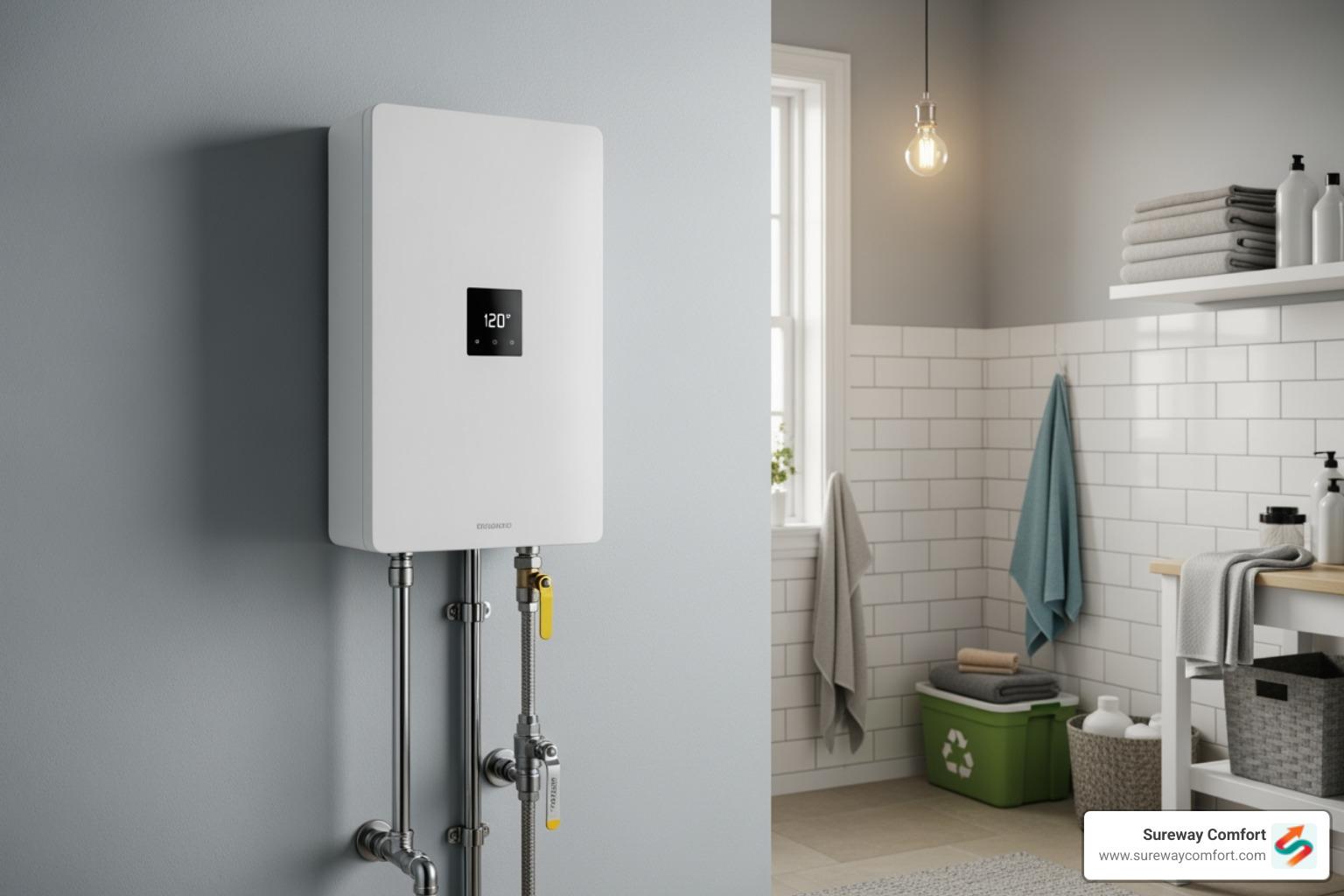




















.avif)



